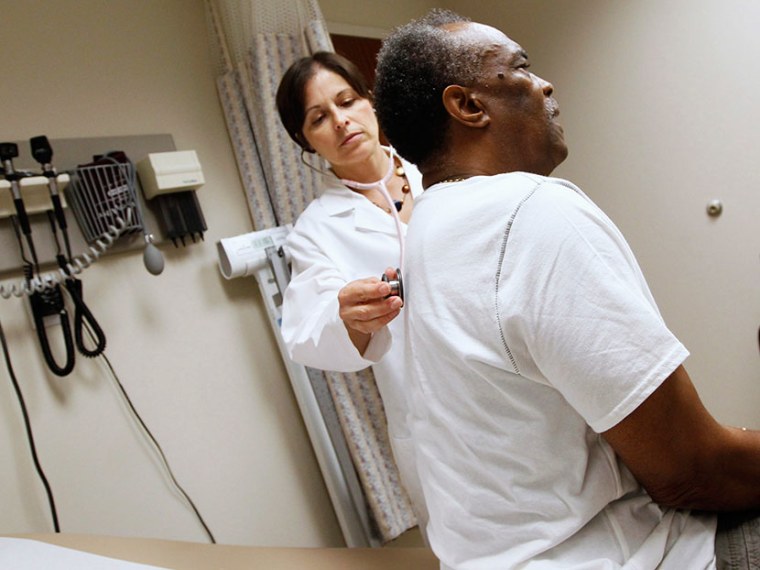No one expects health care costs to decline anytime soon, but the rate of medical inflation has fallen sharply over the past few years, and partisans have competing explanations. Is health care reform making care more efficient and affordable, or has health care spending dipped just because of the recession?
New analysis from PricewaterhouseCooper suggests we’re making real, sustainable progress. In a report released today, the consulting giant’s Health Research Institute predicts what it calls a “historic slowdown” in the rising cost of health care in 2014. Total health care spending may spike as Obamacare draws millions of currently uninsured people into the system. But the report predicts that each person's costs will rise at “some of the lowest levels since the government began measuring national health expenditures in 1960.”
Unlike the 1990s and early 2000s, when double-digit increases in health care spending were the norm, next year will bring only a 6.5% increase, if the report’s projections hold. But because insurers typically dilute price hikes by tweaking benefits, the actual growth rate will likely be closer to 4.5%. That is more than wages will increase, but it marks a significant narrowing of the gap.
What’s driving this auspicious trend? The PwC analysts track the behavior of consumers, providers, insurers and employers, and they see signs of both a decline in the use of costly services (thanks in part to the slow economy) and an increase in the overall quality and efficiency of care (thanks in part to health care reform).
On the “usage” side of the ledger, consumers battered by stagnant wages and aggressive cost-shifting are “questioning and sometimes delaying procedures, imaging, and elective services,” the report observes. The authors view this new restraint not as a fleeting response to the recession, but as a structural change. Employers have responded to rising costs by passing them along to consumers, and consumers are now hitting their own limits. “When you’re less insulated from the real cost of care, it affects the way you behave,” says Ceci Connolly, the managing director of PwC’s Health Research Institute and an author of the report. “People are being more cost-conscious shoppers because they’re spending more of their own money.”
Related: Killer hospital rates: A new tool lets patients compare prices
That’s good news insofar as we’re skipping wasteful, needless services—and bad news to the extent that we’re foregoing needed care. But that’s only part of the story. The report also identifies reforms and innovations that are making needed care more affordable.
One is a simple change of venue. The nation’s overbuilt hospital system has traditionally performed countless functions that can be performed just as well for a fraction of the price in doctors’ offices, in retail clinics, or even remotely via teleconference. Clinics like the ones now appearing in chain drug stores can treat a minor illness for one-seventh the cost of a hospital emergency room ($76 versus $499)—and people actually prefer the experience. The use of retail clinics tripled between 2007 and 2012, and the trend is still young.
Retail clinics are well equipped to manage chronic conditions like diabetes and high blood pressure. Those conditions already account for 75% of all health care spending, and they’re becoming more prevalent as the population ages. “With more than half of the nation’s population expected to have at least one chronic condition by 2020,” the report notes, “the potential [savings are] phenomenal.”
Even when hospital care is unavoidable, new models of reimbursement can make it less exorbitant. Under the traditional fee-for-service billing model, the institution spits out bills for every pill and procedure a patient receives. More procedures mean more profits, and costs soar accordingly. Some companies are now converting to so-called high-performance networks, in which a flat fee (or “bundled payment”) covers the whole cost of an episode such as a heart attack or a kidney transplant. Obamacare encourages this shift in incentives, and early studies suggest it can reduce hospital costs by 10% to 25% without compromising the quality of care.
Obamacare also penalizes hospitals that have to readmit patients within 30 days of discharge, a rough but useful measure of sub-optimal care. The conditions that send people back to their hospital beds—infections, falls, complications—can often be prevented through better care and better follow-up. Readmissions cost $26 billion a year in Medicare expenditures alone, but most hospitals now have programs to prevent them, and the stragglers are racing to institute reforms before the readmission penalties rise under Obamacare next year. Their efforts are expected to save $630 million in 2014 and $1 billion in 2015.
